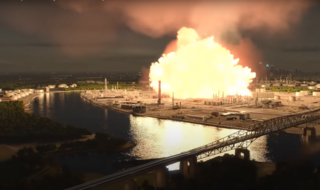
A boiling liquid expanding vapor explosion is an explosion caused by the rupture of a vessel containing a pressurized liquid that is or has reached a temperature sufficiently higher than its boiling point. Because the boiling point of a liquid rises with pressure, the contents of the pressurized vessel can remain a liquid as long as the vessel is intact. If the vessel's integrity is compromised, the loss of pressure drops the boiling point, which can cause the liquid to convert to gas expanding rapidly. BLEVEs are manifestations of explosive boiling.
A chemical accident is the unintentional release of one or more hazardous chemicals, which could harm human health and the environment. Such events include fires, explosions, and release of toxic materials that may cause people illness, injury, or disability. Chemical accidents can be caused for example by natural disasters, human error, or deliberate acts for personal gain. Chemical accidents are generally understood to be industrial-scale ones, often with important offsite consequences. Unintended exposure to chemicals that occur at smaller work sites, as well as in private premises during everyday activities are usually not referred to as chemical accidents.

The Texas City refinery explosion occurred on March 23, 2005, when a flammable hydrocarbon vapor cloud ignited and violently exploded at the isomerization process unit of the BP oil refinery in Texas City, Texas, killing 15 workers, injuring 180 others and severely damaging the refinery. All the fatalities were contractors working out of temporary buildings located close to the unit to support turnaround activities. Property loss was $200 million. When including costs of repairs, deferred production, fines and settlements, the explosion is the world's costliest refinery accident.
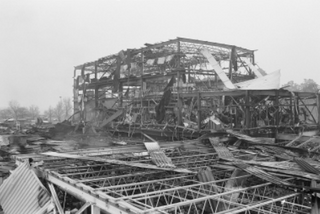
The West Pharmaceutical Plant explosion was an industrial disaster that occurred on January 29, 2003 at the West Pharmaceutical Plant in Kinston, North Carolina, United States. Six people were killed and thirty-six people were injured when a large explosion ripped through the facility. Two firefighters were injured in the subsequent blaze. The disaster occurred twelve years and 170 miles (270 km) from the 1991 Hamlet chicken processing plant fire, North Carolina's second-worst industrial disaster.

The T2 Laboratories explosion and fire occurred on December 19, 2007, in Jacksonville, Florida, resulting in the deaths of four people and the injury of fourteen others. T2 Laboratories Inc. was a facility that specialized in the design and manufacture of specialty chemicals primarily for gasoline additives.

On 7 February 2008, fourteen people were killed and thirty six injured during a dust explosion at a refinery owned by Imperial Sugar in Port Wentworth, Georgia, United States. Dust explosions had been an issue of concern among U.S. authorities since three fatal accidents in 2003, with efforts made to improve safety and reduce the risk of reoccurrence.
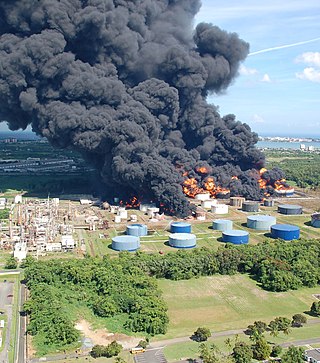
The 2009 Cataño oil refinery fire, also known as the CAPECO explosion, was a fire that began with an explosion on October 23, 2009, and was extinguished on October 25 at the Caribbean Petroleum Corporation (CAPECO) oil refinery and oil depot in Bayamón, Puerto Rico. While the fire and subsequent explosion occurred close to the city of Cataño, it technically occurred within the borders of Bayamón, even though Cataño was more affected by fumes and evacuation. There were no fatalities, but 3 people were injured.
The 2010 Connecticut power plant explosion occurred at the Kleen Energy Systems power station in Middletown, Connecticut, United States at 11:17 am EST on February 7, 2010. The plant had been under construction from September 2007, and was scheduled to start supplying energy in June 2010. The initial blast killed five and injured at least fifty; one of the injured later died in hospital, bringing the total death toll to six.
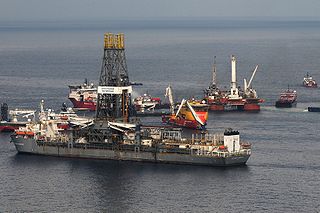
The Deepwater Horizon investigation included several investigations and commissions, among others reports by National Incident Commander Thad Allen, United States Coast Guard, National Commission on the BP Deepwater Horizon Oil Spill and Offshore Drilling, Bureau of Ocean Energy Management, Regulation and Enforcement, National Academy of Engineering, National Research Council, Government Accountability Office, National Oil Spill Commission, and Chemical Safety and Hazard Investigation Board.

On June 10, 1999, the Olympic pipeline operated by Olympic Pipe Line Company, carrying gasoline at the time, exploded in Whatcom Falls Park in Bellingham, Washington. The disaster started at 3:25 PM PDT when a mostly underground gasoline pipeline that crossed Whatcom and Hanna Creeks ruptured due to various errors and malfunctions on the part of Olympic Pipeline and an excavator that failed to call in a locate damaged the pipeline. The gasoline vapors exploded at 5:02 PM PDT, sending a fireball down Whatcom Creek. Three people died in the incident.

On April 17, 2013, an ammonium nitrate explosion occurred at the West Fertilizer Company storage and distribution facility in West, Texas, United States, while emergency services personnel were responding to a fire at the facility. Fifteen people were killed, more than 160 were injured, and more than 150 buildings were damaged or destroyed. Investigators confirmed that ammonium nitrate was the material that exploded. On May 11, 2016, the Bureau of Alcohol, Tobacco, Firearms and Explosives stated that the fire had been deliberately set. That finding has been disputed.
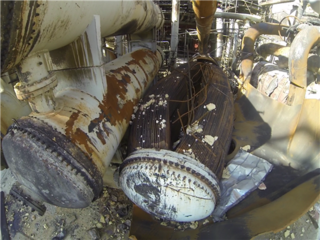
The Williams Olefins Plant explosion occurred on June 13, 2013 at a petrochemical plant located in Geismar, an unincorporated and largely industrial area 20 miles (32 km) southeast of Baton Rouge, Louisiana. Two workers were killed and 114 injured. The U.S. Occupational Safety and Health Administration (OSHA) and the U.S. Chemical Safety and Hazard Investigation Board (CSB) launched investigations to determine how and why the heat exchanger failed. The Chemical Safety Board concluded that a standby heat exchanger had filled with hydrocarbon. This heat exchanger was isolated from its pressure relief; shortly after the heat exchanger was heated with hot water, the hydrocarbon flashed to vapor, ruptured the heat exchanger, and exploded.

Rafael Moure-Eraso is a former chairman and chief executive of the U.S. Chemical Safety and Hazard Investigation Board (CSB).

The 2010 Tesoro Anacortes Refinery disaster was an industrial accident that occurred at the Tesoro Anacortes Refinery in Anacortes, Washington on April 2, 2010. Seven workers received fatal burns in an explosion and ensuing fire when a heat exchanger violently ruptured after a maintenance restart.

Vanessa Lorraine Allen Sutherland is a corporate lawyer and former chairperson of the U.S. Chemical Safety and Hazard Investigation Board (CSB).

Katherine Andrea Lemos is an American safety professional and the former chairperson and CEO of the U.S. Chemical Safety and Hazard Investigation Board (CSB).
An explosion at the ARCO Chemical (ACC) Channelview, Texas petrochemical plant killed 17 people and injured five others on July 5, 1990. It was one of the deadliest industrial disasters in the history of the Greater Houston area.
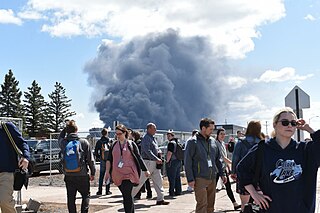
On April 26, 2018, an explosion and subsequent fire occurred at the Husky Energy Oil Refinery in Superior, Wisconsin. An initial explosion was reported at 10:00 AM and was extinguished close to noon, however a piece of debris had hit a storage tank containing asphalt, which ignited after spilling across the refinery, sending a thick plume of black smoke into the air. Thirty-six people, including 11 refinery employees, were sent to local hospitals, but there were ultimately no fatalities. Residents 3 miles to the east and west of the refinery, 2 miles to the north, and 10 miles to the south were evacuated from their homes temporarily due to concerns of both the toxicity of the smoke affecting those who lived south of the refinery and concerns regarding the plant's hydrofluoric acid tank causing further damage.

In the early morning of June 21, 2019, a fire and multiple explosions occurred at the Philadelphia Energy Solutions (PES) refinery in Philadelphia, Pennsylvania. A release of hydrocarbons and hydrofluoric acid in the refinery's alkylation unit caused a ground-hugging vapor cloud which rapidly ignited, leading to three separate explosions minutes apart from each other. The largest explosion, a BLEVE, sent a vessel fragment flying 2,000 feet (610 m) across the Schuylkill River. Five employees sustained minor injuries, but there were ultimately no fatalities. The refinery announced it would shut down operations the same month, and filed for bankruptcy a month later.
















